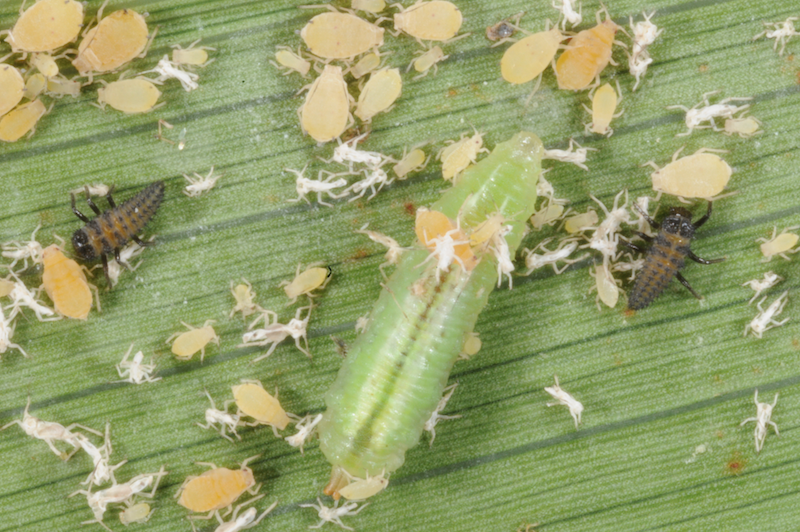Flower Fly Larva, Vol. 8, No. 29
Related News
April 11, 2013
April 2, 2013
March 14, 2013
February 28, 2013

Closely examine a heavy infestation of aphids and you will probably find some flower fly larvae feeding on those aphids. These slow-moving, legless maggots are the immature stage of a group of flies known as flower flies, hover flies, or syrphid flies. Their bodies are peg-shaped, with the head at the pointed end. They use their hook-shaped mouthparts to tear into the bodies of aphids and other small, soft-bodied insects and suck out the body fluids. That pointed structure at the rear of the larva in the photo is a pair of caudal spiracles, through which the insect breathes.
Flower fly larvae, at least those that prey on aphids, are usually green or tan, and grow to about 3/8 inch before pupating. The adults are also called hover flies because of their ability to hover in mid-air like hummingbirds, and they are called flower flies because they are often seen hovering near flowers, where they feed on nectar and pollen. Most adult flower flies are brown or black with yellow stripes and superficially resemble bees or wasps, but flower flies are harmless; they do not sting or bite. However, they do gain quite a lot of protection from potential predators by mimicking stinging insects.
Flower fly larvae are rarely so numerous that they can eliminate an aphid infestation by themselves, but they add to the overall impact of the many predators, parasites and pathogens that help control aphid populations. The aphids in this photo are in trouble, not only is there a ravenous flower fly larva in their midst, but those two lady beetle larvae are young and still have a lot of growing, and eating, to do, and there are probably some parasitic wasps nearby searching for aphids in which to lay their eggs.
Flower flies are a large and varied group. See Bug’s Eye View No. 20 of 2021, Yellowjacket Hover Fly, and No. 2 of 2021, Rat-tailed Maggot, for articles on other flower flies, whose larvae do not feed on aphids.
Blake Layton, Extension Entomology Specialist, Mississippi State University Extension Service.
The information given here is for educational purposes only. Always read and follow current label directions. Specific commercial products are mentioned as examples only and reference to specific products or trade names is made with the understanding that no discrimination is intended to other products that may also be suitable and appropriately labeled. Mississippi State University is an equal opportunity institution.
Bug’s Eye View is now on Facebook. Join the Bug's Eye View Facebook group here.